THE ROAMERS
the art of
ROBERTO ROMEI ROTONDO

by
ROBERT J. LEWIS
_______________________________________________________________________________
When
painting ranks as the supreme value it has no concern
with, and no place in, a social order that, itself, lacks
any supreme value. André Malraux. The Voices
of Silence.
The series
entitled The Roamers, by Italian-born, Montreal-bred, Roberto
Romei Rotondo, is a remarkable achievement because
it challenges our preconceived notions of modern art while revitalizing
an art form that has long since fallen off the critic’s
radar screen. I’m persuaded that the series, completed in
2003, will emerge not only as the artist’s greatest work,
but will come to be viewed as a significant creation because there
is no where for that kind of 3C (color, canvas, and concept) painting
to go. As a modern art that does the past proud, The Roamers,
which exists separate from the ‘isms’ that legislate
rank and relevance, discloses a realm where figuration is subsumed
by abstraction, but never disappears in it. By dispensing with
the conventional foreground-background dynamic, The Roamers satisfies
the conditions of both figurative and abstract art and demonstrates
their easy co-existence. That there is nothing new in this is
to miss the point; the artist is neither an innovator nor obsessed
with notoriety. “I don’t require a hardware store
or plumber’s kit for the materials of my art,” he
declaims.
Rotondo
describes himself as an admirer of de Stael (1914-55) for whom
pure art is incompatible with any conceptual and/or didactic design,
the movement towards which culminates in the art of Rothko and
Newman. If Cezanne’s revolutionary art was motivated by
his fear of pictorial depth disappearing forever, Rotondo, perhaps
fearing for the life of ideas in painting, turns de Stael into
a radical point of departure and evolves, through the introduction
of deliberately open-ended, receding subject matter, a conceptual
art that is metaphysical in reach, where the meaning of a work,
or the series, runs parallel to the viewer’s interrogation
of his own life. At the same time, at the bidding of the viewer,
each work in the series can be appreciated for its decorative,
non-conceptual, surface properties. Through an unlikely marriage
of highly refined Renaissance brush work and Expressionism, the
artist’s layered approach to color and rigorous application
of abstract principles of composition combine to produce two new
aesthetics: of civility and silence, idioms which, prior to Rotondo,
were only partially disclosed, but following the precedent of
Mondrian, whose exemplary compositional formulations have not
been surpassed, adhere to the laws of balance that govern color,
tone/light and volume.
If it
is the unstated ambition of every painter to produce a body of
work that will not only satisfy the conditions of great art but
resonate for all times, he will do so by responding to the significant
concerns of his time in such a way that future generations viewing
his work, will be taught to respond to their own. The Roamers
is a candidate for such an art because -- pacing American literary
critic Robert Trilling -- it competes with the ideas of philosophy
and illuminates the realm of philosophical enquiry like no other
art in the history of contemporary art; and may prove equal to
the ideas of the great religious paintings and statuary that emerged
under Christianity.
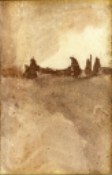
 We
first meet the prototype of The Roamers in a series of unpublished
notebook size monochromatic oil sketches on paper, (2001) called
The Caves, which foretell the color, contours, and conceptual
themes The Roamers will bring to completion 3 years later. In
many of these sketches the protagonists have not so much withdrawn
from the daily grind but have refashioned it to facilitate the
contemplative life. At first glance, we encounter, without fanfare,
unremarkable gatherings of people who are imprecisely engaged
with one another. In the tradition of Van Gogh’s feel for
architecture, (the Church at Auvers), a straight line is not to
be found, while the settings, albeit far removed from modernity,
are neither mythical nor idealized. But when we allow the eye
the time required to meet the work half way, we discover that
the first effect of the diaphanous quality of the sketches is
to mysteriously render unfamiliar that which we would normally
regard as understood, and that what animates these quaint gatherings
is not mere conversation (chatter) but dialogue of the highest
order, the recognition of which becomes both the delight and device
of The Roamers.
We
first meet the prototype of The Roamers in a series of unpublished
notebook size monochromatic oil sketches on paper, (2001) called
The Caves, which foretell the color, contours, and conceptual
themes The Roamers will bring to completion 3 years later. In
many of these sketches the protagonists have not so much withdrawn
from the daily grind but have refashioned it to facilitate the
contemplative life. At first glance, we encounter, without fanfare,
unremarkable gatherings of people who are imprecisely engaged
with one another. In the tradition of Van Gogh’s feel for
architecture, (the Church at Auvers), a straight line is not to
be found, while the settings, albeit far removed from modernity,
are neither mythical nor idealized. But when we allow the eye
the time required to meet the work half way, we discover that
the first effect of the diaphanous quality of the sketches is
to mysteriously render unfamiliar that which we would normally
regard as understood, and that what animates these quaint gatherings
is not mere conversation (chatter) but dialogue of the highest
order, the recognition of which becomes both the delight and device
of The Roamers.
Before
Rotondo turned to painting, he was immersed in the study of philosophy:
Heidegger, Nietzche and the Pre-Socratics. Well before bin Laden
turned the cave into a sound-byte zone, and well after man’s
first essays at primitive art in the caves of Lescaux, Plato’s
cave allegory was the most discussed cave in history and was the
site where philosophical discourse was formalized as a dialectic.
Which is to say, Rotondo’s choice of the cave and variations
as the setting for his sketches and later work is hardly an accident.
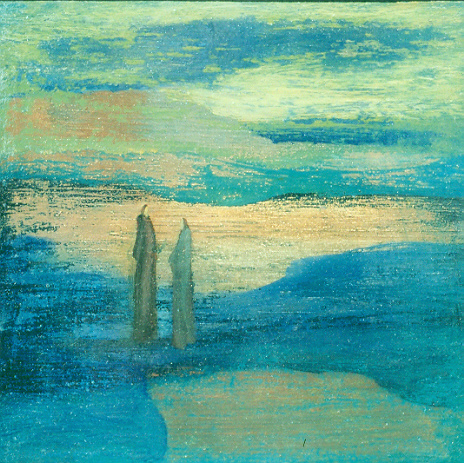 The
seductive qualities of The Roamers cannot be separated from their
philosophical underpinnings. If his work -- most of which features
informal gatherings of people -- doesn’t reveal its meaning
at first glance, the idea of the philosopher kings prevails throughout,
and like a friendly breeze imbues his work with a lyricism that
is tantamount to the artist’s signature.
The
seductive qualities of The Roamers cannot be separated from their
philosophical underpinnings. If his work -- most of which features
informal gatherings of people -- doesn’t reveal its meaning
at first glance, the idea of the philosopher kings prevails throughout,
and like a friendly breeze imbues his work with a lyricism that
is tantamount to the artist’s signature.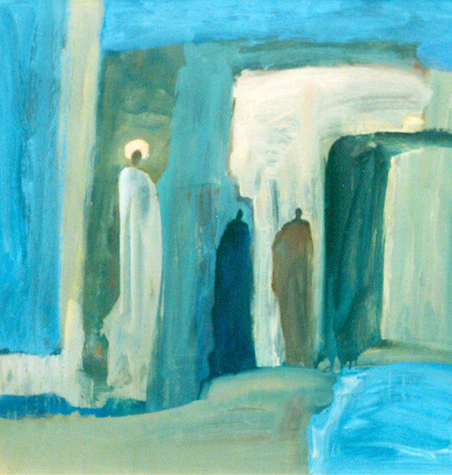 Set against the tempest winds of modernity that provide one rush
after another but no meaningful direction, The Roamers introduces
the notion that there exists a significant connection between
authenticity and serenity, the deficit and syntax to be supplied
by the viewer. Which leads us to the maker’s uncompromising
pallet where paint and meaning are masterfully mixed and singularized,
a feat that speaks to an artist in complete control of his art
and vision, for whom painting is the site where he reveals his
care and concern for the destiny of the world. Unlike abstract
artists, Rotondo refuses to leave the content of art to the caprice
of the beholder, and he categorically rejects the view that art
no longer require a consensus to be significant art. The Roamers
is first and foremost a conceptual art whose agenda is formalized
through its painterly qualities and compositional rigor, where
volume and content are arranged to throw, not into sharp, but
gradual relief the idea that in our rush to modernity we have
lost something vital, an essential part of ourselves; and as the
viewer struggles to uncover the implications, he is introduced
to his own spiritual indices.
Set against the tempest winds of modernity that provide one rush
after another but no meaningful direction, The Roamers introduces
the notion that there exists a significant connection between
authenticity and serenity, the deficit and syntax to be supplied
by the viewer. Which leads us to the maker’s uncompromising
pallet where paint and meaning are masterfully mixed and singularized,
a feat that speaks to an artist in complete control of his art
and vision, for whom painting is the site where he reveals his
care and concern for the destiny of the world. Unlike abstract
artists, Rotondo refuses to leave the content of art to the caprice
of the beholder, and he categorically rejects the view that art
no longer require a consensus to be significant art. The Roamers
is first and foremost a conceptual art whose agenda is formalized
through its painterly qualities and compositional rigor, where
volume and content are arranged to throw, not into sharp, but
gradual relief the idea that in our rush to modernity we have
lost something vital, an essential part of ourselves; and as the
viewer struggles to uncover the implications, he is introduced
to his own spiritual indices.
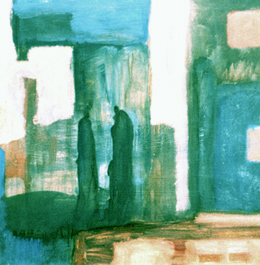 Rotondo’s
narratives unfold in earthy-warm, primitive settings, where elongated,
heaven-wreathed, wraithlike characters gather and engage in civilized,
elevated discourse, to the effect that without knowing why, we
want to be there with them, in their most intimate community,
as if being-there would fill a void his art insists we take notice
of. The relative smallness of his characters set against the immensity
of nature is not a contrived humility, but a proportionate response
to the human condition marked by suffering and loss, events to
which the tormented creator of The Roamers is no stranger.
Rotondo’s
narratives unfold in earthy-warm, primitive settings, where elongated,
heaven-wreathed, wraithlike characters gather and engage in civilized,
elevated discourse, to the effect that without knowing why, we
want to be there with them, in their most intimate community,
as if being-there would fill a void his art insists we take notice
of. The relative smallness of his characters set against the immensity
of nature is not a contrived humility, but a proportionate response
to the human condition marked by suffering and loss, events to
which the tormented creator of The Roamers is no stranger.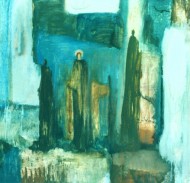
Despite
the cynicism that characterizes modern art in both its content
and execution, The Roamers is an optimistic work, and is the answer
to Munch (Scream) and especially the art that culminates in minimalism.
The artist has laid bare a vision of man, very much of the earth,
of the soil, that invites us to undertake a journey -- the title
of an earlier series -- the purpose of which is what we make of
it, even though it is impossible not to notice that in many of
The Roamers the characters are illuminated by the Christian halo
and its pre-ordained significations. My first thought was do we
have to be told that the artist’s work is underwritten by
his genuine spiritual concerns? After all, aren’t his sublime
personages already somewhere between man and God, already dwelling
in the exalted terracotta of an alternative world? If it is no
secret that the painter is a devoted 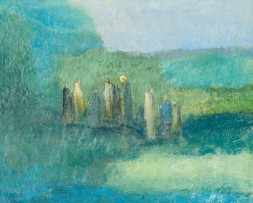 Catholic,
whose life has been informed by the Bible (especially those injunctions
that encourage the partaking of wine), it should be said that
I’m a secularist, drawn toward the all-inclusive, non-denominational
temperament of his work. Which means, as a responsible critic,
it is my duty to declare my own biases and refrain from imposing
them on a body of art whose intentional thrust clashes with my
own. If I disingenuously insinuate my world view onto The Roamers,
I become party to a position that betrays their spirit: a witting
cheerleader or acolyte of modernity for whom secularism is merely
another alibi for another kind of intolerance. For the record,
and for the millions of traditionalists world-wide and the churches
that attend to their spiritual needs, Rotondo’s halo-charged
work will surely find a home, just as the form and hues of his
halos are integral to both the concept and composition of his
work.
Catholic,
whose life has been informed by the Bible (especially those injunctions
that encourage the partaking of wine), it should be said that
I’m a secularist, drawn toward the all-inclusive, non-denominational
temperament of his work. Which means, as a responsible critic,
it is my duty to declare my own biases and refrain from imposing
them on a body of art whose intentional thrust clashes with my
own. If I disingenuously insinuate my world view onto The Roamers,
I become party to a position that betrays their spirit: a witting
cheerleader or acolyte of modernity for whom secularism is merely
another alibi for another kind of intolerance. For the record,
and for the millions of traditionalists world-wide and the churches
that attend to their spiritual needs, Rotondo’s halo-charged
work will surely find a home, just as the form and hues of his
halos are integral to both the concept and composition of his
work.
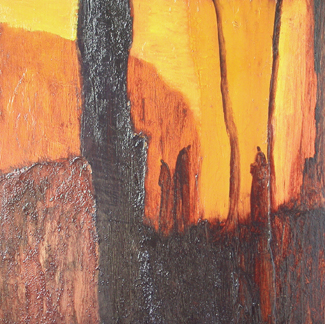 If
what finally distinguishes significant art is its ability to turn
the viewer into an accomplice, Rotondo’s The Roamers answers
every challenge and already stands as a formidable rampart against
what has yet to be properly identified as the crisis in modern
art. Whether or not the next cycle of painting rises to the occasion
of offering a correction to the art -- or what has been passed
off as art -- of the past 50 years, just might depend on the reception
of and precedent set by The Roamers, and in general, the artist
taking responsibility for the unceasing line that charts the ups
and downs, the rises and crises in the history of art.
If
what finally distinguishes significant art is its ability to turn
the viewer into an accomplice, Rotondo’s The Roamers answers
every challenge and already stands as a formidable rampart against
what has yet to be properly identified as the crisis in modern
art. Whether or not the next cycle of painting rises to the occasion
of offering a correction to the art -- or what has been passed
off as art -- of the past 50 years, just might depend on the reception
of and precedent set by The Roamers, and in general, the artist
taking responsibility for the unceasing line that charts the ups
and downs, the rises and crises in the history of art.
All works ©
Roberto Romei Rotondo